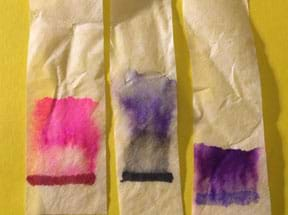Quick Look
Grade Level: Elementary school
Time Required: 45 minutes
Expendable Cost: US $0.40
Group Size: 2
Subject Areas: Chemistry, Physical Science, Problem Solving, Reasoning and Proof, Science and Technology
Introduction
Bolded words are vocabulary and concepts to highlight with students during the activity.
Who has heard of chromatography? Chromatography is a way to look at complex mixtures by separating them into their components. Criminal investigators use this technology to identify substances such as chemicals, blood, ink and other fluids. And, environmental engineers use chromatography to prepare solutions to monitor and test groundwater for contaminants. Different inks have different properties, such as how well they dissolve in certain types of solvents. When you dip a portion of the chromatography paper into the solvent, the solvent begins to move up the paper. As the solvent rises up the paper, it dissolves the ink on the paper into its components. The ink components travel up the paper with the solvent, and the distance they travel is based on how readily each component dissolves in the solvent. What are these components? We are about to find out!
Supplies
Each group needs:
- 1 coffee filter
- isopropyl alcohol
- scissors
- 2 popsicle sticks
- 2 clear plastic cups
- black and colored permanent markers
- tape
- ruler
- paper and pencils
Subscribe
Get the inside scoop on all things TeachEngineering such as new site features, curriculum updates, video releases, and more by signing up for our newsletter!Procedure
Procedure Overview
Students use isopropyl alcohol to separate the components of black and colored permanent ink on coffee filters—the outcome of which is a surprise.
Procedure
- Divide the class into groups of two students each. Hand out the supplies, excluding the isopropyl alcohol.
- Explain to students that their goal today is to use isopropyl alcohol to separate the different colors contained within various permanent marker inks.
- Have groups cut their coffee filters into half inch-wide strips, making sure the ends are square (not rounded).
- Students then take a black marker and draw a line across one strip of coffee filter half an inch from one end. (Note: The line placement needs to be fairly precise, so help students, as necessary.)
- Then, have groups tape the strip to a popsicle stick so that the end with the marker line hangs down from the stick and the bottom of the filter strip just barely rests on the bottom of the cup (see the image).
- When groups are ready, an instructor pours isopropyl alcohol into their cups, ensuring the marker line is above the top of the liquid. (Note: Push the popsicle stick to the edge of the cup to avoid accidentally pouring alcohol on the strip.)
- Have students watch as the liquid moves up the filter and pulls the colored inks out of the ink line.
- When students have finished, ask them to write a description of the colors they found in their black ink.
- Have students experiment with colored markers and also with water rather than alcohol to see if they obtain different results. Have them report their results on their papers.
- Have students compare results and discuss their experiment outcomes.

Wrap Up - Thought Questions
- Were you surprised by the colors that you found in any of the inks?
- Why did you use isopropyl alcohol when doing this experiment?
- Why can't the alcohol touch the line of ink?
More Curriculum Like This

To increase students' awareness of possible invisible pollutants in drinking water sources, students perform an exciting lab requiring them to think about how solutions and mixtures exist even in unsuspecting places such as ink. They use alcohol and chromatography paper to separate the components of...
Copyright
© 2013 by Regents of the University of ColoradoLast modified: May 12, 2022






User Comments & Tips